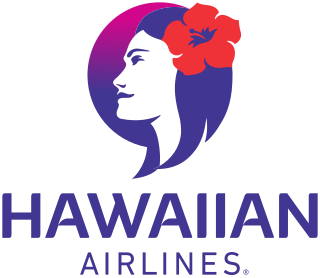
Hawaiian Airlines is a commercial U.S. airline, headquartered at Honolulu, Hawaii. It is the largest operator of commercial flights to and from the island state of Hawaii, and the tenth-largest commercial airline in the United States.

A flight attendant, traditionally known as a steward or stewardess ; or air host or hostess, is a member of the aircrew aboard commercial flights, many business jets and some government aircraft. Collectively called cabin crew, flight attendants are primarily responsible for passenger safety and comfort.
Aloha Airlines was an airline in the United States that operated passenger flights from 1946 until 2008. It was headquartered in Honolulu, Hawaii, operating from its hub at Honolulu International Airport.
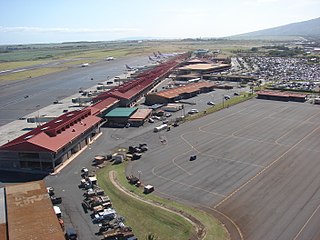
Kahului Airport is the main airport of Maui in the State of Hawaii, United States, located east of Kahului. It has offered full airport operations since 1952. Most flights into Kahului Airport originate from Daniel K. Inouye International Airport in Honolulu; the Honolulu–Kahului corridor is one of the heaviest-trafficked air routes in the US, ranking 13th in 2004 with 1,632,000 passengers.

Aloha Airlines Flight 243 was a scheduled Aloha Airlines flight between Hilo and Honolulu in Hawaii. On April 28, 1988, a Boeing 737-297 serving the flight suffered extensive damage after an explosive decompression in flight, caused by part of the fuselage breaking due to poor maintenance and metal fatigue. The plane was able to land safely at Kahului Airport on Maui. The one fatality, flight attendant Clarabelle "C.B." Lansing, was ejected from the airplane. Another 65 passengers and crew were injured. The substantial damage inflicted by the decompression, the loss of one cabin crew member, and the safe landing of the aircraft established the incident as a significant event in the history of aviation, with far-reaching effects on aviation safety policies and procedures.

Ellison Onizuka Kona International Airport at Keāhole is the primary airport on the Island of Hawaiʻi, located in Kailua-Kona, Hawaii, United States. The airport serves leeward (western) Hawaiʻi island, including the resorts in North Kona and South Kohala. It is one of two international airports serving Hawaiʻi island, the other being Hilo International Airport on the windward (eastern) side.
Island Air was a commuter airline based in Honolulu, Hawaii. It operated scheduled inter-island passenger services in Hawaii. Its main base was the Daniel K. Inouye International Airport on Oahu.

Hana Airport is a regional public use airport of the State of Hawaiʻi on the east shore of the island of Maui, three nautical miles northwest of the unincorporated town of Hana. The airport was officially opened on November 11, 1950. It is primarily a commuter facility used by unscheduled air taxis and general aviation. As air traffic increases, the Hawaiʻi State Legislature will consider future improvements including the construction of a taxiway paralleling the runway, widening of access roads and expansion of passenger terminals and parking facilities.

Hilo International Airport, formerly General Lyman Field, is an international airport located in Hilo, Hawaiʻi, United States. Owned and operated by the Hawaii Department of Transportation, the airport serves windward (eastern) Hawaiʻi island including the districts of Hilo, Hāmākua and Kaʻū, and Puna. It is one of two international airports serving Hawaiʻi island, the other being Kona International Airport on the leeward (western) side.
Waimea-Kohala Airport is a state-owned public-use airport located one nautical mile southwest of Waimea, an unincorporated town in Hawaii County, Hawaii, United States.

British Airways Flight 5390 was a flight from Birmingham Airport in England for Málaga Airport in Spain. On 10 June 1990, the BAC One-Eleven 528FL suffered an explosive decompression. While the aircraft was flying over Didcot, Oxfordshire, an improperly installed windscreen panel separated from its frame, causing the captain to be partially ejected from the aircraft. He was held in place through the window frame for 20 minutes until the first officer landed at Southampton Airport.
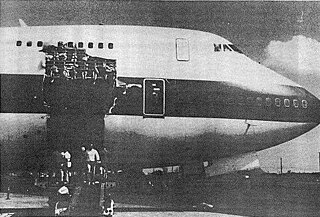
United Airlines Flight 811 was a regularly scheduled airline flight from Los Angeles to Sydney, with intermediate stops at Honolulu and Auckland. On February 24, 1989, the Boeing 747-122 serving the flight experienced a cargo-door failure in flight shortly after leaving Honolulu. The resulting explosive decompression blew out several rows of seats, killing nine passengers. The aircraft returned to Honolulu and landed without further incident.
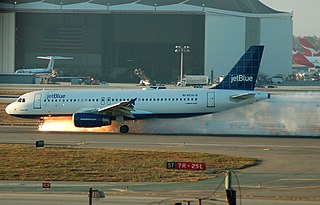
An emergency landing is a premature landing made by an aircraft in response to an emergency involving an imminent or ongoing threat to the safety and operation of the aircraft, or involving a sudden need for a passenger or crew on board to terminate the flight. It typically involves a forced diversion to the nearest or most suitable airport or airbase, or an off airport landing or ditching if the flight cannot reach an airfield. Flights under air traffic control will be given priority over all other aircraft operations upon the declaration of the emergency.

Go! was a regional brand of Arizona-based Mesa Airlines. Go! operated inter-island services within Hawaii. Its main base was Honolulu International Airport. It was a division within the Mesa Airlines subsidiary of Mesa Air Group and its flights were operated by Mesa Airlines. The airline ceased operations in Hawaii on April 1, 2014. The company slogan was Hawaii's Low Fare Airline.
Mokulele Airlines is a regional airline operating in Hawaii. The airline scheduled inter-island and charter flights, primarily between smaller airports and its hubs at Kahului Airport on the island of Maui and Daniel K. Inouye International Airport in Honolulu on the island of Oahu. The airline was acquired by Southern Airways Express in 2019 but continues to operate under its own brand within the larger airline. Both Southern Airways and Mokulele Airlines are subsidiaries of Surf Air Mobility.
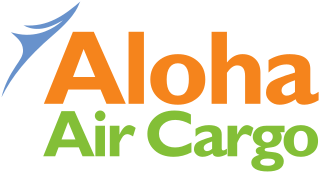
Aeko Kula, LLC, DBA Aloha Air Cargo, is an all-cargo airline in the United States, headquartered in Honolulu, Hawaii, operating from a hub at Daniel K. Inouye International Airport. Formerly Aloha Airlines, it became an independent cargo operator following the closure of the passenger airline in 2008.

Old Kona Airport State Recreation Area is a park built on the site of an old landing strip just north of Kailua, Hawaii County, Hawaii.

Southwest Airlines Flight 812 was a Boeing 737-300 passenger jet that on April 1, 2011, suffered rapid depressurization while cruising at 34,000 ft (10,000 m) near Yuma, Arizona, leading to an emergency landing at Yuma International Airport. Two of the 123 people on board suffered minor injuries. The aircraft was operating Southwest Airlines' domestic scheduled service from Phoenix, Arizona, to Sacramento, California.
Trans Executive Airlines of Hawaii is an American airline headquartered at Daniel K. Inouye International Airport in Honolulu, Hawaii, operating cargo flights under the name Transair and passenger air charter and tour flights under the name Transair Global. The airline was started in 1982 by Teimour Riahi. As of 2019, the airline operated a fleet of six Boeing 737-200 and four Short 360 aircraft.
ʻOhana by Hawaiian was a regional subsidiary carrier of Hawaiian Airlines. The service was operated using four ATR 42 turboprop airplanes owned by Hawaiian and operated under contract by Empire Airlines. The new service was slated to begin in summer 2013 initially flying to Moloka'i and Lana'i; however, the airline was unable to begin operations during that period because of Federal Aviation Administration delays in certifying ʻOhana's operation. During its time of operation, ʻOhana by Hawaiian was fully integrated into the Hawaiian Airlines network.
















